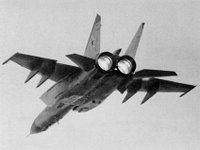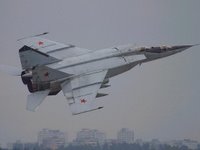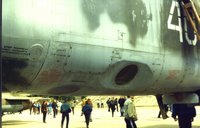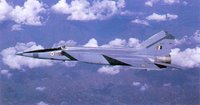 It’s official. The DRDO is a DODO. The Arjun tank is a no-show. The Tejas Light Combat Aircraft still is nowhere near completion in spite of being in development since 1983. The Prithvi missile is already obsolete. The Agni-III fell into the sea during its very first test. The air-force wouldn’t touch the Akash with a ten foot pole. India would certainly be better off without the DRDO, which has done nothing except consume ridiculous amounts of money with no positive output. At least this is what the Indian English-language media would have you believe. I am, of course, referring to the Indian Express’ eight-part exposé on the DRDO, which is one of the most stunning examples of journalistic crap I’ve seen coming from the Indian media in a long time. As if obfuscation and baseless comparisons weren’t enough, the Express has resorted to printing outright lies under the garb of investigative journalism. Because of lack of time and space, I’ve trashed only three of these articles in this post.
It’s official. The DRDO is a DODO. The Arjun tank is a no-show. The Tejas Light Combat Aircraft still is nowhere near completion in spite of being in development since 1983. The Prithvi missile is already obsolete. The Agni-III fell into the sea during its very first test. The air-force wouldn’t touch the Akash with a ten foot pole. India would certainly be better off without the DRDO, which has done nothing except consume ridiculous amounts of money with no positive output. At least this is what the Indian English-language media would have you believe. I am, of course, referring to the Indian Express’ eight-part exposé on the DRDO, which is one of the most stunning examples of journalistic crap I’ve seen coming from the Indian media in a long time. As if obfuscation and baseless comparisons weren’t enough, the Express has resorted to printing outright lies under the garb of investigative journalism. Because of lack of time and space, I’ve trashed only three of these articles in this post.1) 6,000 cr wasted, 10-yr delay & they want 150,000 cr more
 Quite unsurprisingly, the first article of the series is the standard anti-DRDO rant. It seems to me that the Indian Express has a bone to pick with the DRDO. They have apparently missed the plethora of projects that the DRDO has successfully delivered. The Agni Missiles, the Akash SAM's 3D Central Acquisition Radar, the Rajendra Radar (shown right), the Battlefield Surveillance Radar, the MiG-27 and Jaguar upgrades and the Samyukta and Sangraha Electronic Warfare systems are just a few examples of the DRDO's successful endeavours. This article only focuses on the negative aspects of the LCA and the Arjun.
Quite unsurprisingly, the first article of the series is the standard anti-DRDO rant. It seems to me that the Indian Express has a bone to pick with the DRDO. They have apparently missed the plethora of projects that the DRDO has successfully delivered. The Agni Missiles, the Akash SAM's 3D Central Acquisition Radar, the Rajendra Radar (shown right), the Battlefield Surveillance Radar, the MiG-27 and Jaguar upgrades and the Samyukta and Sangraha Electronic Warfare systems are just a few examples of the DRDO's successful endeavours. This article only focuses on the negative aspects of the LCA and the Arjun.
Moeover, the way Amitav Ranjan and Shiv Aroor have compared the DRDO to its Chinese counterparts just goes to show how little they know about defence research in India. It is not the DRDO’s fault that the government doesn’t pour millions of dollars into defence research, as the Chinese do. It is not the DRDO’s fault that the Air Force and Army want world-class products that are also inexpensive and able to keep up with their whimsical requirements.
2) Armed Forces wait as showpiece missiles are unguided, way off mark
 Ranjan and Aroor claim that “former deputy director of the Prithvi project and now DRDO’s chief controller of missiles and strategic systems Dr. V. K. Saraswat’s report RCI/PGT/PGM/1 admits: “Accuracy of missiles like Prithvi is acceptable in surface-to-surface theatre role, but precision strike without collateral damage is not possible with this system.”” I simply cannot bring myself to believe that someone of Dr. Saraswat’s stature could make such a childish statement. Ballistic missiles aren’t designed for precision strike. Their precision is measured in terms of the Circular Error Probable (CEP), which is defined as the radius of a circle into which a missile will land at least half the time. And the CEP of the Prithvi-I (10-75 metres) and Prithvi-II are comparable to similar missiles. The job of precision strike is better left to the precision guided munitions fielded by the Air Force and cruise missiles.
Ranjan and Aroor claim that “former deputy director of the Prithvi project and now DRDO’s chief controller of missiles and strategic systems Dr. V. K. Saraswat’s report RCI/PGT/PGM/1 admits: “Accuracy of missiles like Prithvi is acceptable in surface-to-surface theatre role, but precision strike without collateral damage is not possible with this system.”” I simply cannot bring myself to believe that someone of Dr. Saraswat’s stature could make such a childish statement. Ballistic missiles aren’t designed for precision strike. Their precision is measured in terms of the Circular Error Probable (CEP), which is defined as the radius of a circle into which a missile will land at least half the time. And the CEP of the Prithvi-I (10-75 metres) and Prithvi-II are comparable to similar missiles. The job of precision strike is better left to the precision guided munitions fielded by the Air Force and cruise missiles.
Also notice the way they imply that the Agni-III is a failure, because it “plunged into the sea after just five minutes of flight in July”. What they don’t mention is that such high-tech missiles do fail on their first test flights, as the American MX-774, or Russia’s latest Bulava SLBM did. That is certainly not a reason to just give up on their development, because, last I knew, no country was ready to violate the Missile Technology Control Regime to provide India with a long-range ballistic missile capable of carrying nuclear weapons.
Another ridiculous claim by the two journalists is about how “an exasperated IAF, which calls Phase-I user trials (of the Akash SAM) unsatisfactory, has decided to buy Israeli Spyder missile systems instead”. This, when it is known that the short-ranged Spyder is supposed to make up for the lack of the Trishul.
But this one takes the cake: “Saraswat’s report calls for integrating Nag’s seeker with Prithvi to make the latter a precision-guided munition (PGM) but that hasn’t worked either”. Anyone with basic knowledge of missile guidance would know that simply bolting an IIR seeker of an anti-tank missile onto a hulking big ballistic missile which flies many times faster and wishing it would turn it into a fantabulously cool PGM is nothing short of stupid.
 This article is a perfect example of how, through selective reporting and obfuscation, one can trash a perfectly fine product, and make it look inferior to what can be bought in the Chor Bazaar for half the price. The two “journalists”, while glibly proclaiming how “the T-90, a far superior tank, can kill the Arjun” don’t elaborate on exactly how they arrived at this conclusion. I suppose they have access to the results of Arjun v/s T-90 tests in different scenarios, because, as a professional journalist, I would have balked at making such apparently baseless statements without solid proof. But then again, this is the Indian media we are talking about. They claim that the Arjun weighs much more than the T-90 without attempting to explain where all the extra weight comes from. My logic tells me that the Arjun has heavier and superior armour. So do many reputed publications. Maybe the American M1A1, the German Leopard-II, and the British Challenger-II are horrible tanks too. In fact, they are even heavier than the Arjun! But the Pakistani Al-Khalid, being the lighter tank, is obviously superior! Going by that logic, the answer to our troubles lies in (hold your breath) the venerable Maruti-800! It has everything the DDM claims the Arjun lacks. It is cheap, mobile, light, air-conditioned, and nimbler than the vaunted T-90. Plus, with our present railway infrastructure we can easily carry it to border areas. Sure, the Arjun trounces the Maruti-800 (and the T-90) when it comes to sheer firepower, armour, crew protection, crew comfort, and electronics. But since when have these things been important?
This article is a perfect example of how, through selective reporting and obfuscation, one can trash a perfectly fine product, and make it look inferior to what can be bought in the Chor Bazaar for half the price. The two “journalists”, while glibly proclaiming how “the T-90, a far superior tank, can kill the Arjun” don’t elaborate on exactly how they arrived at this conclusion. I suppose they have access to the results of Arjun v/s T-90 tests in different scenarios, because, as a professional journalist, I would have balked at making such apparently baseless statements without solid proof. But then again, this is the Indian media we are talking about. They claim that the Arjun weighs much more than the T-90 without attempting to explain where all the extra weight comes from. My logic tells me that the Arjun has heavier and superior armour. So do many reputed publications. Maybe the American M1A1, the German Leopard-II, and the British Challenger-II are horrible tanks too. In fact, they are even heavier than the Arjun! But the Pakistani Al-Khalid, being the lighter tank, is obviously superior! Going by that logic, the answer to our troubles lies in (hold your breath) the venerable Maruti-800! It has everything the DDM claims the Arjun lacks. It is cheap, mobile, light, air-conditioned, and nimbler than the vaunted T-90. Plus, with our present railway infrastructure we can easily carry it to border areas. Sure, the Arjun trounces the Maruti-800 (and the T-90) when it comes to sheer firepower, armour, crew protection, crew comfort, and electronics. But since when have these things been important?
 The Express also makes a big fuss about how the temperature inside the Arjun reaches an “abnormal” 55 degrees. But it fails to mention the reason why this happens. After all, the DRDO had offered an air-conditioned Arjun to the Army, but the latter rejected the idea. So, is the temperature problem the fault of the Army or the DRDO? And the T-90 has faced problems with high interior temperatures too - its thermal imagers packed up in the blistering heat of the Thar. It was unable to fire the Reflecks missile until quite recently. The engine had its own problems. So why was it accepted with such alacrity? Why was it not subject to rigorous testing the way the Arjun was? Why was the Arjun supposed to be a tank that was heavily armoured, comfortable, fast, small, light, and cheap at the same time? Why was it subjected to continuously changing goalposts? Why does everyone seem to suffer from memory loss when one mentions how the initial requirements, which called for a relatively simple 40-ton tank to replace the Vijayanta, were changed when Pakistan decided to acquire the formidable M1A1 Abrams? Maybe Ranjan and Aroor, in their infinite wisdom, would like to tell us how the DRDO (or anyone else for that matter) can design such a tank in a short span of time.
The Express also makes a big fuss about how the temperature inside the Arjun reaches an “abnormal” 55 degrees. But it fails to mention the reason why this happens. After all, the DRDO had offered an air-conditioned Arjun to the Army, but the latter rejected the idea. So, is the temperature problem the fault of the Army or the DRDO? And the T-90 has faced problems with high interior temperatures too - its thermal imagers packed up in the blistering heat of the Thar. It was unable to fire the Reflecks missile until quite recently. The engine had its own problems. So why was it accepted with such alacrity? Why was it not subject to rigorous testing the way the Arjun was? Why was the Arjun supposed to be a tank that was heavily armoured, comfortable, fast, small, light, and cheap at the same time? Why was it subjected to continuously changing goalposts? Why does everyone seem to suffer from memory loss when one mentions how the initial requirements, which called for a relatively simple 40-ton tank to replace the Vijayanta, were changed when Pakistan decided to acquire the formidable M1A1 Abrams? Maybe Ranjan and Aroor, in their infinite wisdom, would like to tell us how the DRDO (or anyone else for that matter) can design such a tank in a short span of time.
Generally speaking, the writers seem to have spent all their time coming up with creative titles for each part of the series, rather than doing what they are paid to do – report the facts as they are. Adding insult to injury is the fact the Indian Express has spoken of DRDO's apparently non-existent accountablity, while they themselves are accountable to no one. The DRDO will not sue them for libel. The goverment will make a few noises about how things have to be improved. The educated public, which knows squat about defence, will feel proud of our “free” and “empowered” media, which in reality, thrives on lies, half-truths, and sensationalism. All of which reminds me of the Michael Jackson number, “Tabloid Junkie”
It’s slander
You say it's not a sword
But with your pen you torture men
You'd crucify the Lord
Recommended reading material on the DRDO:
- The DRDO Webpage
- DRDO on Wikipedia - This page contains a list of most (if not all) successful DRDO projects.
- India developing new missiles Towards destroying hostile missiles
- An excellent three part series on the DRDO by rediff
- The Army and the Arjun Experiment - Lt. Gen Niranjan Malik, PVSM (Retd.)









